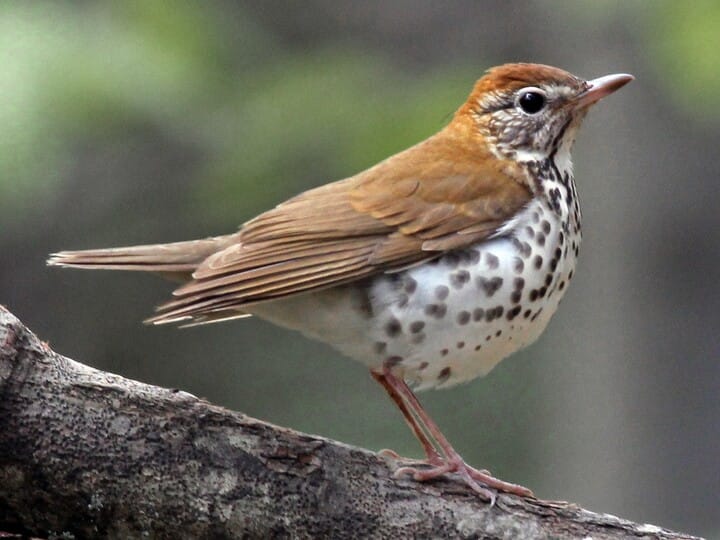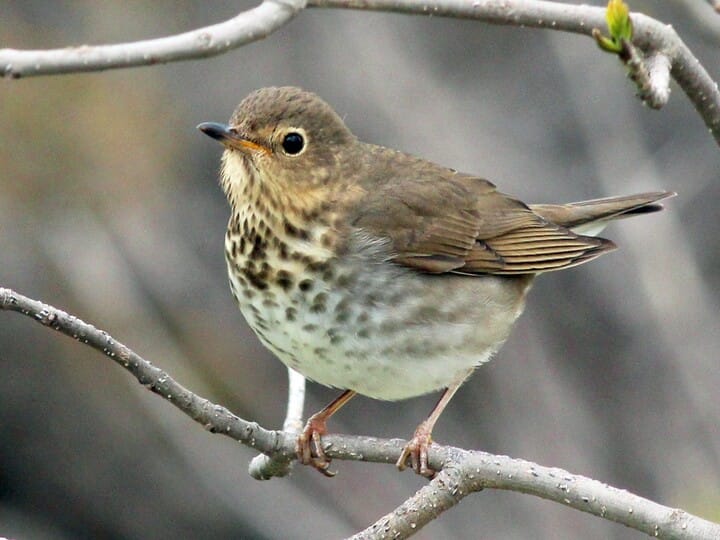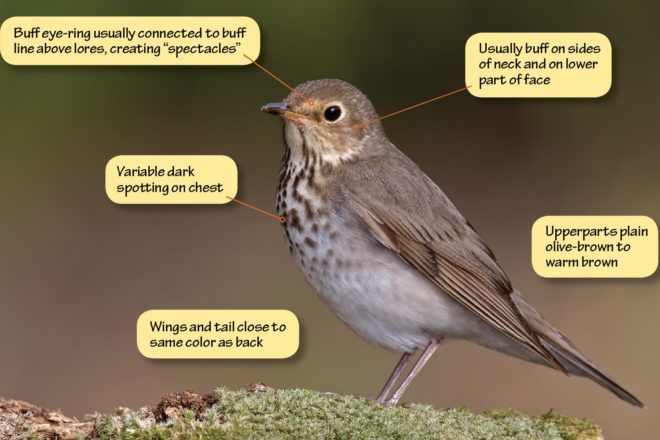Birdwatching enthusiasts often debate the differences between the Hermit Thrush and Swainson’s Thrush. Both birds are fascinating and share many similarities.
Comparing these two thrushes can help birdwatchers and nature lovers recognize them better. The Hermit Thrush and Swainson’s Thrush have distinct features and behaviors that make each unique. Understanding these differences can enhance your birdwatching experience. Whether you are a beginner or an expert, knowing how to identify these birds can add depth to your appreciation of nature.
Let’s explore what sets the Hermit Thrush apart from Swainson’s Thrush and delve into their fascinating world.
Physical Characteristics
Understanding the physical characteristics of the Hermit Thrush and Swainson’s Thrush can help bird enthusiasts identify these birds more easily. Both species share similarities but also have distinct differences. Let’s explore their size, shape, color, and markings.
Size And Shape
The Hermit Thrush typically measures about 6.7 inches in length. It has a wingspan of around 11.4 inches. Its body is compact with a fairly short tail. The Swainson’s Thrush, on the other hand, is slightly larger. It measures about 7.5 inches in length and has a wingspan of approximately 12 inches. Its body is more elongated with a longer tail.
Color And Markings
The Hermit Thrush has a brownish upper body and pale underparts. Its breast shows distinct dark spots. The bird’s tail is reddish, which is a key identifier. The Swainson’s Thrush features a more uniform brown color. Its underparts are lighter with a buffy wash on the chest. The spots on its breast are less prominent compared to the Hermit Thrush.

Credit: www.allaboutbirds.org
Habitat And Range
Understanding the habitat and range of Hermit Thrush and Swainson’s Thrush is crucial for bird watchers. These birds share some similarities, but their preferred environments and geographical distribution differ significantly. Let’s explore where you can find these two charming species.
Geographical Distribution
Hermit Thrushes are found across North America. They breed in Canada and the northern United States. During winter, they migrate to the southern United States, Mexico, and Central America. Their range is wide and spans diverse regions.
Swainson’s Thrushes also have a broad range. They breed in the boreal forests of Canada and the northern United States. During migration, they travel to Central and South America. These birds cover vast distances during their annual migration.
Preferred Environments
Hermit Thrushes prefer mixed woodlands. They thrive in forests with dense undergrowth. They also favor areas with a mix of trees and shrubs. You can often find them in mountainous regions. Their adaptability allows them to inhabit various forest types.
Swainson’s Thrushes favor dense, moist forests. They are often found in riparian areas near streams and rivers. They prefer habitats with thick vegetation for cover. They also thrive in coniferous and deciduous forests. Their preferred environments offer ample food and shelter.
Behavioral Traits
Hermit Thrushes display shy behavior, often staying hidden in dense woods. Swainson’s Thrushes show more curiosity, frequently exploring open areas. Both birds sing beautifully but have distinct calls.
Behavioral Traits Understanding the behavioral traits of Hermit Thrush and Swainson’s Thrush can give us a deeper appreciation for these wonderful songbirds. Their unique habits and interactions with their environment reveal a lot about their survival strategies. Let’s dive into some of the fascinating aspects of their behavior.Feeding Habits
Hermit Thrushes have a varied diet. They often feed on insects and small invertebrates during the summer. In the winter, they switch to berries and fruits. This adaptability helps them survive in different seasons. Swainson’s Thrushes, on the other hand, are more dependent on fruits, even during the breeding season. I once watched a Swainson’s Thrush spend several minutes meticulously picking berries from a bush, showing their preference for this food source. Both thrushes forage on the ground, but Hermit Thrushes tend to be more solitary. They hop around quietly, often flicking their wings. Swainson’s Thrushes, however, are more social and may be seen in small groups.Mating And Nesting
Hermit Thrushes are known for their beautiful, flute-like songs during mating season. Males sing to attract females and establish territories. Their nests are usually built on the ground or low in bushes, made from a mix of grass, leaves, and moss. Swainson’s Thrushes also use song to attract mates, but their nests are typically placed higher in trees. They use twigs, leaves, and grasses to build their nests. I once found a Swainson’s Thrush nest nestled safely in the fork of a tree branch, about ten feet off the ground. Both species are protective of their nests. Hermit Thrushes are particularly secretive, often leading predators away from the nest by pretending to be injured. Swainson’s Thrushes, while also protective, tend to rely more on the nest’s camouflage. Have you ever observed these birds in their natural habitat? Noticing their unique behaviors can make birdwatching a more enriching experience.Vocalizations
Bird enthusiasts often delight in the vocalizations of thrushes. The Hermit Thrush and Swainson’s Thrush, both noted songbirds, have distinctive calls. Understanding their vocal differences can enhance birdwatching experiences.
Song Patterns
The Hermit Thrush song is ethereal and flute-like. Its melody starts with a clear note and spirals into a series of musical phrases. Each phrase ends in a higher pitch. This creates a hauntingly beautiful echo in the woods.
Swainson’s Thrush, on the other hand, sings a rising spiral song. Its melody ascends in pitch, giving a sense of upward movement. The song is less varied but still melodious. Birdwatchers describe it as a soft, rising trill.
Call Differences
Hermit Thrushes have a sharp, distinctive “chup” call. This sound is often heard during flight or when the bird is alarmed. It is short and loud, making it easy to identify.
Swainson’s Thrush calls with a soft “whit” sound. This call is less sharp and more delicate. It is often heard during migration. The call helps birdwatchers locate the bird in dense foliage.
Migration Patterns
Hermit Thrushes and Swainson’s Thrushes have fascinating migration patterns. Their journeys cover thousands of miles. Despite their similarities, their migration routes and destinations differ greatly.
Seasonal Movements
Hermit Thrushes migrate primarily to escape harsh winters. They travel from northern regions to warmer southern areas. This migration takes place in late fall. They return to their breeding grounds in early spring.
Swainson’s Thrushes also migrate to avoid cold weather. Their migration begins in late summer. They move from North America to Central and South America. They return north in late spring to breed.
Routes And Destinations
Hermit Thrushes follow a direct route. They travel through the United States to reach Mexico and Central America. Some may winter in the southern United States. Swainson’s Thrushes take a more complex route. They fly through the eastern and western United States. They then cross the Gulf of Mexico. Their final destinations include Panama, Colombia, and Venezuela.
Their routes are influenced by geography and weather patterns. Both species face many challenges during migration. Despite these challenges, their remarkable journeys ensure their survival and reproduction.

Credit: www.allaboutbirds.org
Conservation Status
The conservation status of bird species helps us understand their survival challenges. Both Hermit Thrush and Swainson’s Thrush face unique conservation issues. Understanding these can help in making informed conservation efforts.
Population Trends
Hermit Thrush populations remain relatively stable. They adapt well to various environments. Swainson’s Thrush populations are declining. Habitat loss is a significant factor in their decline.
Threats And Protection
Hermit Thrush faces threats from habitat destruction. Urban development and deforestation are major concerns. Swainson’s Thrush is also threatened by habitat loss. Climate change poses additional risks to their survival.
Conservation efforts focus on habitat preservation. Creating protected areas helps both species. Monitoring populations is crucial for ongoing conservation. Public awareness campaigns can support these efforts.
Identification Tips
Identifying birds can be a delightful yet challenging experience, especially when dealing with similar species like the Hermit Thrush and Swainson’s Thrush. Understanding subtle differences can make all the difference. Here are some tips to help you distinguish between these two fascinating birds.
Field Marks
One of the most reliable ways to identify these birds is by looking at their physical features.
Hermit Thrushes have a reddish tail that contrasts with their olive-brown back. They also have a distinctive eye-ring which is less pronounced than that of Swainson’s Thrush.
Swainson’s Thrushes sport a more uniform olive-brown color. Their eye-ring is bold and stands out more, almost like wearing spectacles.
Check their spots. Hermit Thrushes have larger, darker spots on their breast, while Swainson’s Thrushes have smaller, less distinct spots.
Behavioral Cues
Behavior can also offer clues. Hermit Thrushes are more likely to be seen alone or in pairs, often flicking their wings and tail.
Swainson’s Thrushes, on the other hand, are more social and can be found in small groups, especially during migration.
Listen to their calls. Hermit Thrushes have a hauntingly beautiful, flute-like song. Swainson’s Thrushes sing a series of ascending, spiraling notes.
Notice how they feed. Hermit Thrushes often forage on the ground, flipping leaves to find insects. Swainson’s Thrushes prefer to pick insects from foliage or catch them mid-air.
Have you ever spotted these thrushes in your backyard? Next time you see one, try these tips to identify it. You might be surprised at how much you can learn just by paying attention to the details.

Credit: www.birdwatchingdaily.com
Frequently Asked Questions
How To Tell Hermit Thrush From Swainson’s Thrush?
Hermit Thrush has a reddish tail and sings a clear, flute-like song. Swainson’s Thrush features a buffy eye ring and more uniform brown color.
What Is The Difference Between A Hermit Thrush And A Swainson?
A Hermit Thrush has a reddish tail and sings a haunting, flute-like song. A Swainson’s Thrush has a buffy eye-ring and a spiraling, upward song.
What Is The Difference Between Wood Thrush And Hermit Thrush?
Wood Thrush has a reddish-brown back and a bold, white eye-ring. Hermit Thrush has a brown back and less distinct eye-ring.
What Is The Difference Between Swainson’s Thrush And Veery?
Swainson’s thrush has a buffy eye-ring and spotted chest. Veery has a faint eye-ring and less distinct chest spots.
Conclusion
Both the Hermit Thrush and Swainson’s Thrush have unique qualities. Hermit Thrush sings sweetly and prefers forests. Swainson’s Thrush enjoys wetlands and has a distinctive call. Birdwatchers find joy in observing both species. Each bird offers a special experience in nature.
Explore their habitats to appreciate their beauty. Simple outings can lead to memorable sightings. Enjoy the sounds and sights they bring. Respect their environments for future generations. Happy birdwatching!
